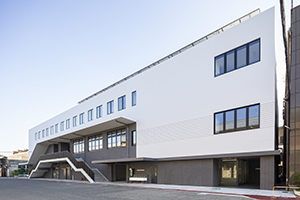1937
Groundbreaking ceremony held for Head Office and Kawasaki Plant
Planned to construct a new plant in Shiohama-cho, Kawasaki City, Kanagawa Prefecture, to increase production capacity. Land acquisition was completed.
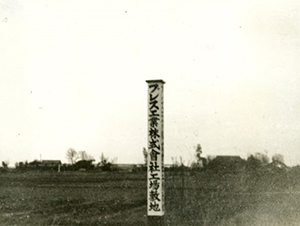
1937
Completion of Head Office and Kawasaki Plant; Headquarters functions and equipment relocated
The factory building was completed, and headquarters functions and equipment were relocated from the former head office in Oi, Ebara-gun, Tokyo.
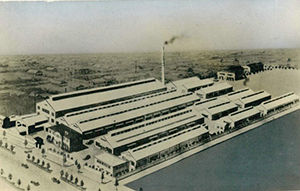
1941
Introduced 1,500-ton press manufactured in Germany by WEINGARTEN
Strengthened equipment to handle large volumes of military orders. Gained attention for its high precision.
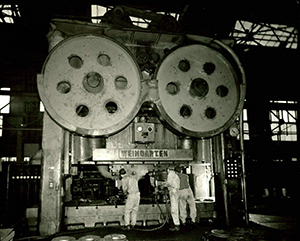
1945
Partial damage due to air raid
While preparing for evacuation to Nagano Prefecture in April, the facility was hit by a U.S. air raid. Fortunately, an incendiary bomb penetrated the roof and embedded in the office floor without exploding.
1945
Production resumed
Following temporary dissolution after the end of the war in August, machines sent to Nagano were retrieved and production resumed. Products included bicycle parts, agricultural machinery parts, and consumer goods.
1954
Started production of axle cases for heavy-duty trucks
Built a new plant on the site of former tennis courts and sumo practice grounds behind the factory, introducing welding machines and other equipment. Started production with a team of 25 members.

1959
Expanded facilities including installation of 3,000-ton hydraulic press
Due to increased production, acquired adjacent land and carried out sequential expansion and renovation of buildings, including installation of additional press machines.
Video playback is available.
1962
Employee welfare hall completed
Constructed a three-story welfare hall to enhance employee welfare facilities amid company growth. The first floor had a clinic and lockers, the second floor had a large cafeteria, and the third floor had conference rooms.
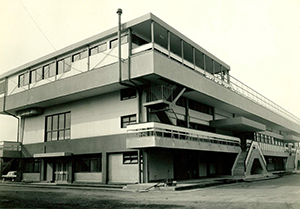
1965
New head office building completed
To commemorate the 40th anniversary, constructed a five-story head office building. Held a completion celebration in June along with the anniversary ceremony.
Video playback is available.
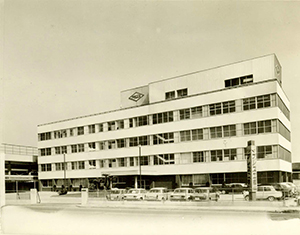
1966
Installed a 4,000-ton single-action crankless press machine
Installed single-action crankless press machine, the largest of its kind in Japan, to produce side members for large frames.
Video playback is available.
1972
Established frame assembly line for heavy-duty trucks
In response to the increasing size of trucks at the time, established a press line and automated the frame painting process from degreasing to primer application.
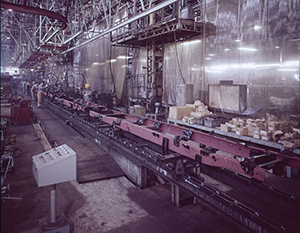
1976
Started production of stamped parking pallets
Formed the main body using a 4,000-ton press and completed welding assembly. Delivered to Nissan’s finished vehicle warehouse.
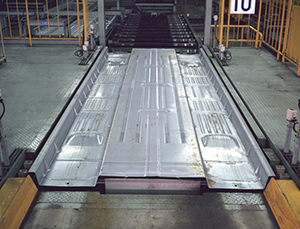
1976
Installed first NC-piercing machine
To improve drilling accuracy and reduce manual labor, our Tooling Department manufactured and installed the machine. Mainly used for machining frame cross members.

1980
Installed NC-piercing machine for frame side member web surfaces
Later, in November 1981, a second unit was installed, followed by an NC machining unit for flange surfaces in November 1984.
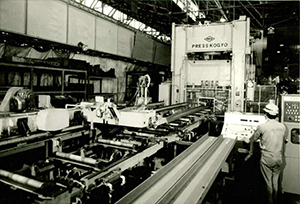
1984
Fully automated frame painting line became operational
Completed frames were transported by chain conveyor through electrostatic painting and touch-up processes, significantly improving the working environment.
1988
Second office building completed
Constructed a three-story reinforced concrete office building. The first floor had a clinic and security office, the second floor had the Kawasaki Plant’s administration, and the third floor had the Design and Overseas Business Departments.
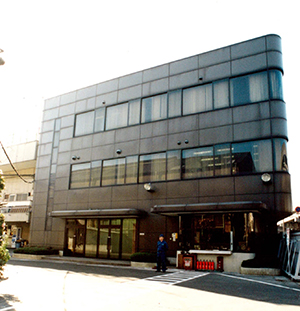
1990
Started production of counterweight covers for construction machinery
Successfully began press forming covers for hydraulic excavator counterweights using a 3,000-ton hydraulic press. Started production for Hitachi Construction Machinery.
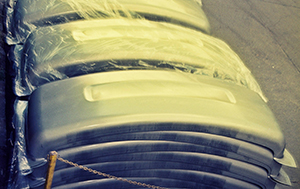
1992
Achieved non-changeover production on second axle line for heavy-duty trucks
Following the establishment of a cell production system for parts installation in 1989, implemented plasma cutting for round bars and automation of temporary ring fitting.
1993
Established dedicated line for super frames
Established a dedicated line for super frames (web-fastened large frames) for Mitsubishi Motors. An automatic riveting machine was installed in May.
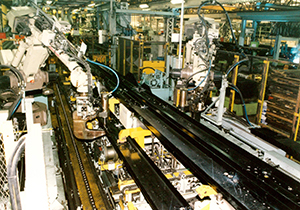
2000
Acquired ISO 9001 certification
2000
Removed the 1,500-ton press manufactured by “WEINGARTEN”
Removed the 1,500-ton press manufactured by “WEINGARTEN,” which had been in operation for 59 years, due to aging. Production of railway vehicle components was discontinued.
2007
Transferred production of Isuzu large and medium truck frames to other plants and terminated operations
In response to the closure of Isuzu’s Kawasaki Plant, production of truck frames for Isuzu was transferred to the Fujisawa, Utsunomiya Plants as part of production restructuring.
2008
Began assembly of axle units for MFTBC trucks
Received transfer of assembly lines from Mitsubishi Fuso Truck and Bus Corporation (MFTBC), and started production axle units for heavy and light-duty trucks.
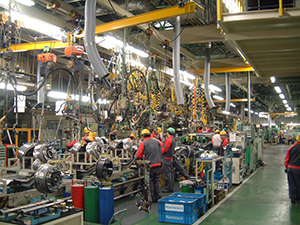
2013
Seismic reinforcement of Head Office; Welfare Building demolished
Due to seismic safety concerns, the welfare hall was dismantled and removed. Seismic reinforcement was carried out on the head office building, and facilities such as the cafeteria and lockers were relocated.
2024
New office and Welfare Building completed
As part of the 100th anniversary projects, a three-story office and welfare building was constructed on the site of the former welfare hall. The first floor had a clinic, the second floor had a large cafeteria, and the third floor had the Kawasaki Plant's administration.
